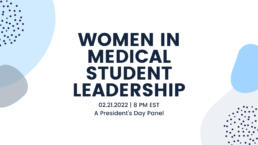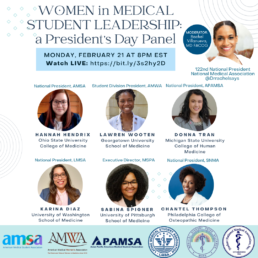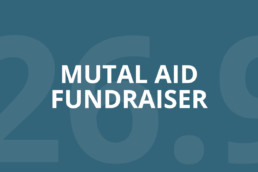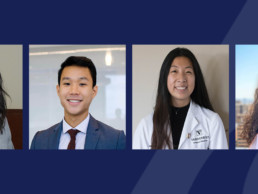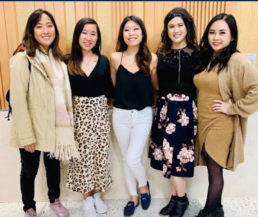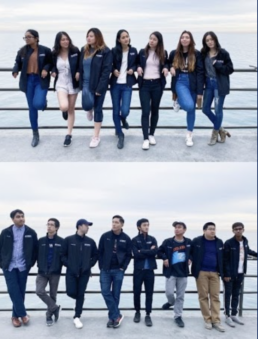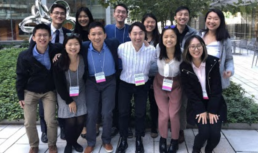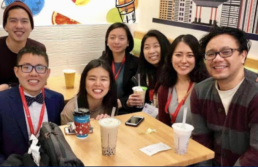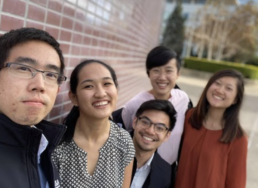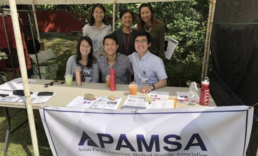Women in Medical Student Leadership Panel
Date: Feb 21, 2022 8:00 PM Eastern Time (US and Canada)
STREAM HERE: https://bit.ly/3HrMxK
Spend an evening with the student leaders from the American Medical Student Association (AMSA), American Medical Women’s Association (AMWA), Asian Pacific American Medical Student Association (APAMSA), Latino Medical Student Association (LMSA), Medical Student Pride Alliance (MSPA) and the Student National Medical Association (SNMA) as they discuss the road to national leadership, their roles and how they push their organizations forward while balancing the demands of medical school.
COVID-19 Vaccination Toolkit
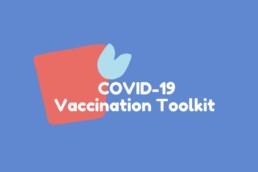
This document is a compilation of resources that address vaccine hesitancy and access for AANHPI communities, particularly focused on providing linguistically and culturally appropriate information. A study conducted by UCSF this year found that 34% of AAPI respondents were concerned about the vaccine’s side effects, 6% were worried about vaccine safety, and 36% had multiple concerns regarding the vaccine.
Moreover, the barriers faced by AANHPI individuals during COVID is telling of other long-standing challenges the community has faced historically. One such problem is with data disaggregation. Many locales do not even include Asian American as an option for ethnicity in surveys, let alone subdivisions of the vast diversity within the AANHPI community. COVID-19 morbidity and mortality are also not well studied for AANHPI populations. From the sparse data that we do have, we know that many of the disparities in care are masked. For instance, in NYC’s public hospital system, South Asians had the second highest rate of positivity (after Hispanics) and second highest rate of hospitalization (after Blacks), and Chinese patients had the highest mortality of all groups. Despite this, Asian Americans are not listed as a vulnerable population by the National Academy of Sciences Engineering Medicine*. In the absence of disaggregated data, it is difficult to allocate appropriate resources to address problems like vaccine hesitancy and access barriers for the diverse AANHPI groups in the country.
Thus, we hope that this document is able to provide the language and resources for AANHPI medical students to speak to their family, friends, and others in the community to better address the concerns and questions about COVID-19 and the vaccine.
APAMSA offers Community Outreach Grants to chapters that may want to reach out to their local communities. For more information contact the outreach@apamsa.org.
*For more information on how COVID-19 has impacted AANHPI subgroups, please refer here.
Table of Contents
How to Address Vaccine Hesitancy:
Chinese (Simplified/Traditional):
How to Address Vaccine Hesitancy:
Guide to COVID-19 Vaccine Communication
Chinese (Simplified/Traditional):
CDC Viral Vector Vaccines Infosheet / CDC Viral Vector Vaccines Infosheet
CDC mRNA Vaccines Infosheet / CDC mRNA Vaccines Infosheet
LA County Vaccine FAQ / LA County Vaccine FAQ
CT Official Website COVID-19 Facts / CT Official Website COVID-19 Facts
How did the vaccine get developed so quickly? / How did the vaccine get developed so quickly?
Is the vaccine safe? / Is the vaccine safe?
Pfizer and Moderna Ingredients / Pfizer and Moderna Ingredients
Avoiding Vaccine Scams / Avoiding Vaccine Scams
Vaccine Safety Video / Vaccine Safety Video
Geographic Specific Information:
Hindi:
CT Official Website COVID-19 Facts
How did the vaccine get developed so quickly?
Pfizer and Moderna Ingredients
Hmong:
Japanese:
Karen:
Khmer:
CT Official Website COVID-19 Facts
How did the vaccine get developed so quickly?
Pfizer and Moderna Ingredients
Korean:
CDC Viral Vector Vaccines Infosheet
CT Official Website COVID-19 Facts
How did the vaccine get developed so quickly?
Pfizer and Moderna Ingredients
Geographic Specific Information:
-
CA:
-
NYC:
Lao:
CT Official Website COVID-19 Facts
Pfizer and Moderna Ingredients
How did the vaccine get developed so quickly?
Nepali:
Tagalog:
CDC Viral Vector Vaccines Infosheet
Geographic Specific Information:
Tamil:
Telugu:
Thai:
Vietnamese:
CDC Viral Vector Vaccines Infosheet
CT Official Website COVID-19 Facts
How did the vaccine get developed so quickly?
Pfizer and Moderna Ingredients
Geographic Specific Information:
APAMSA Mutual Aid Fundraiser: Thank You for Your Support!
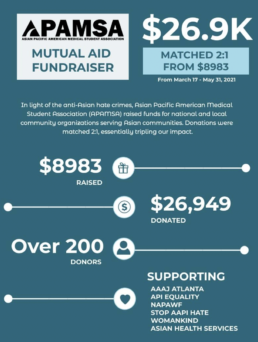
The APAMSA Mutual Aid Fundraiser, in response to anti-Asian hate, ended on May 31, 2021. With your help, we exceeded our goal of $8888, raising over $8900 matched to a total of over $26.9K! The final amount was distributed to AAAJ Atlanta, API Equality, Asian Health Services, NAPAWF, Stop AAPI Hate, and Womankind. Thank you all for your commitment in supporting these wonderful organizations!
#APAMSAVotes2020
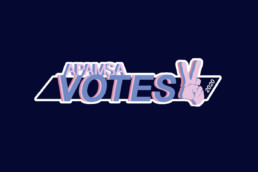
This is completely nonpartisan. It’s not about party – it’s about maintaining our democracy.
Thank you to all of you that have voted early thus far! APAMSA has partnered with Vote Early Day, a collective multi-disciplinary movement working to ensure all Americans know their options to vote early. Most people can still vote early, from now until Election day. Find out your specific early voting options here: https://www.voteearlyday.org/vote-early/
Why vote?
-
Both medical students and AAPI voters have traditionally low turnout rate
-
Issues critical to our communities are at stake, including the COVID-19 response, healthcare, and immigration policy
-
Free swag!!
How do I register?
Click here for state-specific instructions. No online voter registration in your state? NVRD will mail you a pre-filled registration form – click here!
*Some states have deadlines as early as 10/3, so check now!*
How do I vote?
-
Early Voting
In some states, there is an in-person early voting option prior to Election Day, where registered voters may cast a ballot in a designated period prior to Election Day. Each state or jurisdiction have varying rules and times, please check the details in your state.
-
Absentee Voting (By Mail)
-
Absentee ballots are available to voters in all states, with different restrictions depending on the state. The form that absentee voting takes varies—generally, absentee voting consists of a ballot mailed to your residence, allowing you to cast a vote prior to—or by—Election Day by mail.
-
Many states allow you to vote absentee without an excuse or specific reason, while other states will require an excuse for you to vote absentee.
-
Most states require you to request an absentee ballot by a predetermined deadline before each election.
-
Election Day Voting (voting in-person)
-
The general election in 2020 is on November 3, 2020.
-
You may vote in person on Election Day, but you may be required to vote in designated locations and within the hours the polling places are open.
-
Some states require a valid photo ID before you cast your ballot, or else you will cast a provisional ballot. Check your state’s voter ID requirements here. As Election Day draws closer, you may find your polling location here.
Have questions or need help voting? Call 1-888-API-VOTE (1-888-274-8683).
Bilingual assistance is available in English, Mandarin, Cantonese, Korean, Vietnamese, Tagalog, Urdu, Hindi, and Bengali.
For more voter information in other languages, click here!
(Some information on this page courtesy of APIA Votes.)
Other ways to contribute to the democratic voting process:
(more details in the upcoming days–visit this page for up to date instructions/additional resources added)
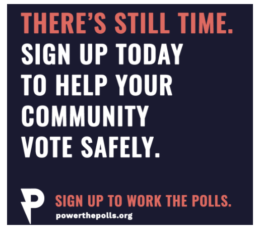
Phone banking with APAMSA (coming soon!)
APAMSA has partnered with Power the Polls to help engage people to sign up to be poll workers–young people are particularly important as they are not only the future of our democracy, but also because of the current pandemic!
Sign up to become a paid poll worker here!
APAMSA Interim Executive Board Feature
Happy August, APAMSA! This month, we will be featuring our interim executive board members, who will be serving in this capacity until the 2021 National Conference elections.
-
Interim President: Donna Tran, M3 at Michigan State University College of Human Medicine
-
Interim Advocacy Vice President: Leena Yin, M3 at University of California, San Francisco
-
Interim Membership Vice Presidents: Sai Mupparaju, M3 at Sidney Kimmel Medical College; Jonathan Weng, M2 at NYU Grossman School Of Medicine; Rachel Chang, M3 at Vanderbilt SOM
-
Interim Health Affairs Vice President: John Yuen, G2 at Renaissance School of Medicine at Stony Brook University
This passionate and hardworking group is excited to serve you all! Here, you can read about their favorite APAMSA memories, how they became involved, and their vision for our organization.
Questions? Contact Ryan at communications@apamsa.org.
- Your favorite APAMSA memory:
Donna: During my undergrad at UC Davis, I was actively involved with a Vietnamese Asian American org called VN CARES and that experience sparked my passion for serving vulnerable APIA communities. I knew in medical school I wanted to rekindle my experience in meeting other like-minded APIA individuals who also wanted to better their communities and the world. I literally Googled “Asian medical student association” and found APAMSA. After I joined MSU’s local APAMSA, the rest was history 😉
Leena: I joined my local chapter upon entering medical school, then started getting involved with national advocacy while coordinating our local efforts organizing against the Trump administration’s public charge rule (which has a temporary nationwide injunction, by the way!). Our chapter ended up winning Best Chapter in Advocacy that year, so I traveled to National Conference to accept the reward and also run for Health Advocacy Director. I knew I’d made the right decision when I met all the dope people on National Board!
Jonathan: Upon starting medical school, I quickly met and befriended members of my local chapter. In October, NYU auspiciously hosted the National Conference, during which I became more familiar with the vision, structure, and leadership of national APAMSA. Applying for a Regional Director position post-conference proved to be one of the best decisions of my first year, and I am honored to now serve in this interim capacity.
Sai: I became involved with APAMSA after attending the National Conference in 2019. I was curious about this amazing group and jumped right in as one of the Region 3 Regional Directors!
Rachel: I first became involved through my local APAMSA chapter at Vanderbilt – as someone who’s lived in California all my life, I found the adjustment to the South a big one in terms of food, people, and culture. I later took on more responsibility as a Region IV director in planning a conference at Vanderbilt to promote awareness of APA/AAPI issues in the South, and as an Advocacy Director in my APAMSA Vanderbilt chapter, I facilitated a resident panel and led an open discussion on microaggressions directed towards Asian and Asian American health care professionals/students. Throughout my two years, I’ve found a community in APAMSA that has transcended my time here at Vanderbilt – whether it’s through connecting with students from other medical schools who I share experiences with as an APA individual in the South, or through reuniting with APAMSA alumni at conferences and back in California.
John: I’ve been involved in APAMSA since I was an undergrad at NYU, where I was a part of the eboard of its newly founded pre-med chapter. I was approached by a couple of friends with the prospect of being actively involved in promoting AAPI health and I couldn’t say no. About six years later, that same sentiment is why I’m still involved with APAMSA.
3. What motivated you to run for your position? What are your plans for your position during your term?
Donna: I ran for Interim President (IP) because I wanted to make meaningful systemic changes with our fellow APAMSA friends during this difficult 2020 year. Running for IP while being EVP/CFO is a big undertaking but with the support of the Executive and National Board, I knew in my heart it was possible. I am humbled and grateful for this opportunity to serve everyone in APAMSA and our APIA communities.
For my term, I hope to help others engage in meaningful virtual activities (like our 2021 virtual National Conference!) while encouraging APIA diversity and leadership development for all our students. Our Executive Board has wonderful ideas to implement and I look forward to supporting everyone. Thank you!
Leena: The Advocacy Branch has only been around for 3 years, but we have a lot of momentum, and it’s clearer than ever that the AAPI healthcare community has a role – and more importantly, a responsibility – to fight for justice in all its forms. So I feel passionately about both pushing APAMSA as an organization to become a national leader in advocacy and empowering our members to learn how to advocate throughout their careers.
Our focus in the next year will be to follow the lead of our professional AAPI health org counterparts in fighting for policies that benefit our communities, share resources and educational opportunities around advocacy for our students, and build solidarity with our peer organizations!
Jonathan: This past year as an RD instilled in me the understanding that the National Board exists to unite and serve our ~130 local chapters across the country. The foundation of APAMSA membership enables all other NB branches to run effectively, from holding conferences and community health events to advocating for the underserved and oppressed (whether AAPI or not) to connecting and inspiring the next generation of physicians who will promote the health of the AAPI community. In all, it is no exaggeration to say that APAMSA membership crucially contributes to bettering the national landscape of AAPI health.
The interim Membership VPs have already begun implementing our vision for APAMSA membership! The most pressing issue involves regrouping our constituent chapters on a local and regional level. We have been seeking to first understand the needs of our chapters in this unusual time before supporting them in helpful and practical ways.
Beyond simply doing damage control, we are taking advantage of this era of virtual learning and communication to connect chapters and hold events that would not normally transpire under a primarily in-person paradigm. The iMVPs are particularly interested in improving regional and national documentation, including recordkeeping of these novel events and structures, for the betterment of future APAMSA members and leaders. We continue to recruit new chapters, especially premed ones, even as we concurrently foster long-term professional and personal relationships between existing members at the local, regional, and national levels.
Finally, we, along with the rest of the Executive Board, are currently in the process of rethinking the structure of APAMSA membership as we aim to steward our ever-growing role in national AAPI health.
Sai: I wanted to help APAMSA have better communication between National and our local chapters. I noticed that oftentimes there was not enough communication and our local chapters were unsure of what National APAMSA was up to. I hope that increasing communication will further promote the family-like feeling APAMSA has.
I also wanted to help spearhead promoting diversity in APAMSA and help increase South Asian, Southeast Asian, and Pacific Islander representation among our membership!
Rachel: As a Region IV Director, I hosted our multi-institutional Region IV conference 20/20: Visualizing Health and Beyond at our own Vanderbilt campus, which featured speakers discussing community health and healthcare for immigrants and refugees, mindfulness and physical health, and mental health in APA communities.
I was motivated to run for interim MVP in order to share my experiences of promoting and fostering awareness on APA issues in schools in the South, compared to those on the Northeast or the West. These regional differences play a huge part in our individual experiences, and meeting the needs of our local chapters necessitates a deep understanding of each region’s interests and capacity. Additionally, I wanted to expand communication between MVPs and RDs, and RDs and local chapter leadership in order to facilitate idea sharing and determining the needs of our chapters. As an interim MVP and with my fellow iMVPs Sai and Jonathan, we have already begun our work in facilitating our virtual regional conferences in light of COVID-19 and holding an RD Town Hall. We are in the process of finalizing a Local Chapter Resources Guide, which we hope to distribute to all local chapters in order to inspire events, gain more familiarity with National Board and its opportunities, and improve transparency on grants and other funding available for chapter events. Finally, we are continuing to recruit new chapters to our APAMSA family.
John: The umbrella of Health Affairs revolves around being engaged in the community and again, is one of the reasons why I love being a part of APASMA. COVID-19 has obviously made it difficult for us to reach our communities. 2020 is perceived as this series of unfortunate events, but I think that with the pandemic and the increased energy our country (and the world) has in tackling injustice and inequity, this is an amazing time for APAMSA’s 120+ chapters to assess the needs of their communities and make concrete steps in meeting them. During my term, I hope to provide all of our chapters with ideas and resources to kickstart (virtual) events this upcoming academic year, starting with putting out a guide to getting more involved in Health Affairs. Additionally, we are planning on working with the Advocacy Branch on items such as voter registration!
4. What are your interests/passions/hobbies? (outside of APAMSA, of course :D)
Donna: Bouldering/rock climbing, Yelp Elite foodie, ocean beach, nerdy TV shows (Doctor Who and Game of Thrones)
Leena: I read a lot of manga and webnovels, drink a lot of boba, and love karaoke (outside of COVID times).
Jonathan: Outside of APAMSA, my interests include playing and listening to music, playing and watching basketball, and studying and practicing theology. I enjoy spending alone time with a book, but there is nothing quite like the company of friends and family. If I were not an aspiring physician, I might have pursued a career in technology, finance, or ministry.
Sai: If COVID were not happening, I would often be found in some hipster cafe, in a dance class, or wandering around Philly. Now, I’m obsessed with doing Chloe Ting workouts, different coffee brews to make at home (and compensate for no cafes), and still dancing around my apartment.
Rachel: I love reading, running, the beach, boba, and watching bad reality TV D:
John: I love watching/playing/breathing basketball, drinking craft beer, and cooking!
